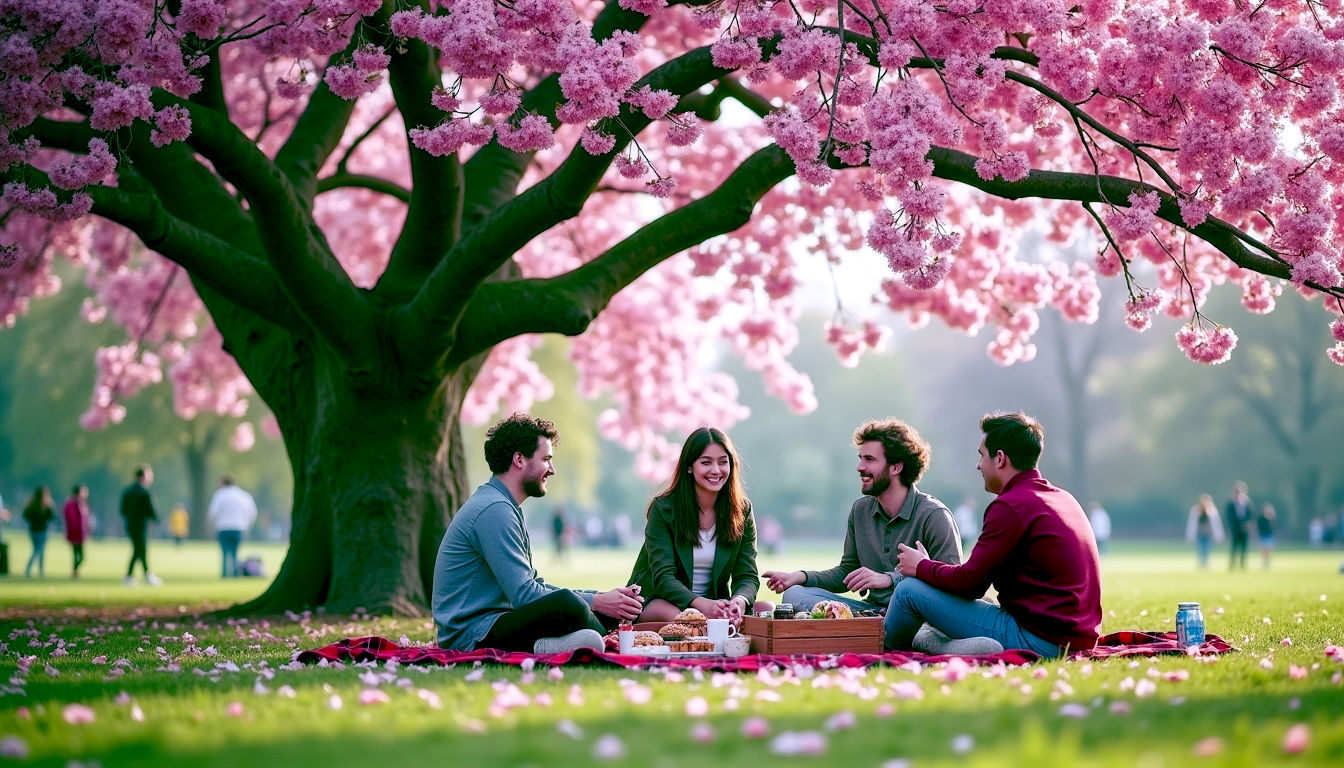The Ultimate Guide to Hanami: A British Introduction to Japan’s Cherry Blossom Spectacle
What is Hanami? Explore Japan’s beautiful cherry blossom tradition and learn how you can celebrate it with our complete guide, from its history to the best UK spots.

This post may contain affiliate links. If you make a purchase through these links, we may earn a commission at no additional cost to you.
Picture this: you’re sat on a tartan blanket in a park, the early spring sun is trying its best to warm your face, and you’re surrounded by friends, a Tupperware box of sausage rolls, and a flask of tea. It’s a familiar British scene. Now, imagine that instead of the usual oak or sycamore trees, you’re sitting under a canopy of breathtakingly beautiful, candyfloss-pink blossom. The air is filled with a light, sweet scent, and delicate petals drift down around you like snowflakes. This, in essence, is Hanami.
Hanami (花見), which literally translates to “flower viewing,” is one of Japan’s oldest and most beloved traditions. It’s the annual celebration of the fleeting beauty of cherry blossoms, known as sakura (桜). But it’s so much more than just looking at flowers. It’s a cultural phenomenon, a nationwide party, and a time for quiet reflection all rolled into one. It’s about friends, family, food, and drink, all enjoyed under the stunning, short-lived sakura.
For centuries, the Japanese have gathered to marvel at these blossoms, understanding that their beauty is all the more precious because it doesn’t last. It’s a bit like that one perfect week of British summer – you have to drop everything and enjoy it before it’s gone. This guide will take you on a journey through the heart of Hanami, from its ancient origins in Japan to the best spots to see cherry blossoms right here in the UK. So, grab a brew, get comfortable, and let’s explore this beautiful Japanese tradition.
What Exactly is Hanami? The Core of the Celebration
At its simplest, Hanami is the tradition of viewing and appreciating the beauty of flowers, especially cherry blossoms. When the sakura trees bloom across Japan, which happens for only a week or two each year, people flock to parks, shrines, and temples to hold flower-viewing parties.
These gatherings aren’t stiff, formal affairs. They’re lively picnics that can last all day and often continue into the evening. A Hanami party typically involves:
- Securing a good spot: Competition for the best locations under the fullest trees can be fierce. It’s not uncommon for someone to arrive in the early morning and lay down a blue tarpaulin (a Hanami essential) to reserve a space for their friends or colleagues who will arrive later.
- Feasting and drinking: Hanami picnics are all about sharing delicious food and drinks. People bring elaborate bento boxes, make special seasonal treats, and enjoy everything from beer and sake to tea.
- Socialising: It’s a time to catch up with family, friends, and co-workers. Office Hanami parties are a common way for colleagues to bond outside the formal work environment.
- Appreciating the moment: While it’s a social event, the heart of Hanami is still about taking a moment to pause and appreciate the stunning but temporary beauty of the blossoms.
In the evening, the celebration often continues as yozakura (夜桜), which means “night sakura.” Many popular Hanami spots hang paper lanterns in the trees, illuminating the blossoms against the dark sky. This creates a magical, almost dreamlike atmosphere that’s completely different from the daytime viewing experience.
More Than Just a Pretty Flower: The Deeper Meaning of Sakura
To truly understand Hanami, you need to understand the cultural importance of the sakura itself. In Japan, the cherry blossom is more than just a tree; it’s a powerful national symbol that represents several deep philosophical ideas.
The most important of these is the concept of mono no aware (物の哀れ). This phrase is a bit tricky to translate directly, but it essentially means a gentle sadness or awareness of the transience of things. It’s the understanding that everything in life—beauty, joy, and life itself—is temporary. The sakura, which blooms so spectacularly for just a brief period before its petals fall, is the perfect embodiment of this idea.
This concept is deeply rooted in Buddhism, which has had a profound influence on Japanese culture. Buddhist teachings emphasise the impermanence of life, and the sakura serves as a beautiful, annual reminder of this truth. The blossoms encourage people to live in the present and appreciate the beauty around them before it fades.
The sakura also symbolises renewal and hope. Because the blossoms appear at the beginning of spring, they mark the end of winter and the start of a new season. The Japanese financial and school year also begins in April, coinciding with the peak of the sakura season. For this reason, the blossoms are associated with new beginnings, fresh starts, and optimism for the future.
A Stroll Through History: The Origins of Hanami
The tradition of Hanami isn’t a modern invention; its roots stretch back over a thousand years to the Nara Period (710–794). However, back then, the flower of choice wasn’t the cherry blossom. The aristocrats of the Imperial Court were actually more interested in ume (梅), or plum blossoms. These flowers, originally imported from China, were admired for their strong, sweet fragrance and were the stars of the earliest flower-viewing parties.
From Plum to Cherry: A Shift in Taste
Everything changed during the Heian Period (794–1185). The Japanese began to develop a stronger sense of their own unique culture, separate from Chinese influences. Around this time, the sakura started to capture the nation’s heart. Emperor Saga, who reigned in the early 9th century, is said to have hosted the first-ever cherry blossom viewing parties under the sakura trees in the Imperial Court in Kyoto.
This new love for sakura was cemented in Japanese literature. The Kokin Wakashū, an early anthology of poetry, dedicated two full volumes to poems about cherry blossoms, compared to just one for plum blossoms. The famous novel The Tale of Genji, also from the Heian Period, contains vivid descriptions of Hanami parties held by the court nobles.
Hanami for Everyone: From Nobles to Common Folk
For centuries, Hanami remained a sophisticated pastime exclusive to the emperor, his court, and the samurai elite. It was a chance for them to write poetry, play music, and enjoy refined feasts under the blossoms.
The tradition began to filter down to the common people during the Edo Period (1603–1868). The Shogun Tokugawa Yoshimune played a key role in popularising Hanami. He had large groves of cherry trees planted in public areas so that everyone, not just the wealthy, could enjoy their beauty. This is when Hanami transformed into the lively, sometimes rowdy, public celebration we know today. People from all walks of life began to gather for picnics, drink sake, and celebrate the arrival of spring under the sakura.
The fundamental spirit of Hanami hasn’t really changed since then. It remains a cherished tradition that brings people together to celebrate the simple, fleeting beauty of nature.
The Star of the Show: Understanding Sakura Varieties
When we talk about cherry blossoms, many of us in the UK might picture a single type of tree. But in Japan, there are over a hundred different varieties of sakura, each with its own unique characteristics. They vary in colour, size, number of petals, and the shape of the tree itself.
Here are a few of the most famous and beloved varieties:
Somei Yoshino (Yoshino Cherry)
This is, without a doubt, the most common and iconic cherry tree in Japan. When you see photos of riversides and parks blanketed in white and pale pink blossoms, you’re almost certainly looking at Somei Yoshino. Its flowers have five petals and are nearly pure white, with just a hint of the palest pink at the base. These trees were first cultivated in the Edo Period and are now planted all over the country. One of their most interesting features is that they all bloom and shed their petals at roughly the same time, creating that famous, unified “blossom front” that sweeps across Japan.
Yamazakura (Mountain Cherry)
As its name suggests, this is a wild variety of sakura that grows naturally in the mountains of Japan. Its blossoms are typically a faint pink and have five petals. Unlike the Somei Yoshino, the Yamazakura’s leaves sprout at the same time as its flowers, giving the tree a slightly different look. It’s a hardier tree and has been a favourite in Japanese art and poetry for centuries.
Shidarezakura (Weeping Cherry)
The Shidarezakura is easily one of the most elegant and dramatic cherry trees. Its branches droop downwards like a willow, creating a cascading waterfall of pink blossoms. These trees can live for a very long time, and some ancient Shidarezakura in Japan are considered national treasures. The Miharu Takizakura in Fukushima, for example, is a famous weeping cherry tree that is thought to be over 1,000 years old.
Kanzan
This is a popular variety from the Yaezakura group, which includes all cherry trees with more than five petals. The Kanzan’s flowers are large, showy, and a deep, vibrant pink. Each blossom can have as many as 30–50 petals, giving them a rich, fluffy appearance. They also tend to bloom a little later in the season than the Somei Yoshino, extending the Hanami period. You’ll find plenty of these in British parks, as their bright colour and robust nature make them a popular choice.
The Hanami Forecast: Chasing the Blossom Front
Because the sakura season is so short and so important, accurately predicting when the blossoms will open is a national obsession in Japan. This is the job of the Japan Meteorological Agency. Every year, starting in March, they release official cherry blossom forecasts, or sakura zensen (桜前線), which literally means “cherry blossom front.”
This forecast tracks the movement of the blooming cherry trees as they sweep across the country, starting from the warmer southern islands of Okinawa in January and slowly moving northwards, usually reaching Tokyo and Kyoto in late March or early April, and finally arriving in the northern island of Hokkaido in May.
The media provides daily updates, and people across the country use these forecasts to plan their Hanami parties with military precision. Major news channels will have maps showing the percentage of blossoms open in each city, from “budding” to “full bloom” (mankai) and finally “petals falling.” This level of excitement is hard to imagine here, but it’s a bit like the nation collectively holding its breath, waiting for the perfect moment to celebrate.
The Taste of Spring: Hanami Food and Drink
A Hanami party wouldn’t be complete without a delicious spread of food and drink. While you can bring almost anything to a Hanami picnic, there are a few traditional items that are specially associated with the season.
Hanami Bento (花見弁当)
The centrepiece of any Hanami meal is the bento, a packed lunchbox. A Hanami bento is often more elaborate and beautifully arranged than an everyday bento. It’s filled with a colourful assortment of seasonal treats, with pink, red, and white colours often used to echo the blossoms.
Common items you might find inside include:
- Makizushi: Rolled sushi, which is easy to pack and share.
- Inarizushi: Pockets of sweet, fried tofu filled with sushi rice.
- Tamagoyaki: A sweet, rolled Japanese omelette.
- Kamaboko: Pink and white fish cakes, sliced to show their decorative patterns.
- Onigiri: Rice balls, sometimes coloured pink with sakura denbu (a sweet, fluffy fish floss).
- Karaage: Japanese-style fried chicken.
Hanami Dango (花見団子)
This is perhaps the most iconic Hanami sweet. Dango are chewy, sweet dumplings made from rice flour. For Hanami, they are served on a skewer in a specific order of three colours: pink, white, and green. The colours represent the order of the season: the pink of the spring blossoms, the white of the lingering winter snow, and the green of the new summer grass to come. There’s a famous Japanese proverb, hana yori dango (花より団子), which translates to “dumplings rather than flowers.” It’s a playful saying used to describe someone who is more interested in the practical things in life (like food) than in abstract beauty (like flowers).
Sakuramochi (桜餅)
Another popular Hanami sweet is sakuramochi. This is a pink-coloured rice cake filled with a sweet red bean paste and wrapped in a pickled sakura leaf. The leaf is edible and its salty, slightly sour taste provides a wonderful contrast to the sweetness of the rice cake and filling. The combination of sweet and salty flavours is a classic feature of Japanese cuisine.
Drinks for the Occasion
When it comes to drinks, anything goes, but sake (Japanese rice wine) is the traditional choice. Drinking sake under the sakura trees has been a part of Hanami for centuries. Beer is also incredibly popular, and you’ll see many groups enjoying cans of local brews like Asahi or Sapporo. For those who prefer something non-alcoholic, green tea, barley tea (mugicha), and a wide variety of soft drinks are common.
Hanami Etiquette: How to Party Politely
While Hanami is a relaxed and joyful occasion, there are a few unwritten rules of etiquette to follow to ensure everyone has a good time. If you ever find yourself at a Hanami party in Japan, or even at a busy blossom spot in the UK, it’s good to keep these in mind.
- Don’t Harm the Trees: This is the most important rule. Never shake the branches, climb the trees, or pick the blossoms. The trees are delicate and are there for everyone to enjoy. You should also be careful not to sit on the tree roots, as this can damage them.
- Reserve Your Spot Respectfully: While it’s common to reserve a spot with a groundsheet, don’t take up more space than you need. In very popular parks, there may be rules about how early you can lay your sheet down.
- Keep it Clean: This is a big one. Take all of your rubbish with you when you leave. Most parks will have designated bins, but it’s common practice to bring your own bin bags and sort your rubbish for recycling. Leaving a mess is considered very poor form.
- Be Mindful of Your Neighbours: Hanami parties can be lively, but be considerate of the groups around you. Don’t play music too loudly or be overly rowdy, especially in quieter areas like temple or shrine grounds.
- Take Your Shoes Off: If you’re sitting on a groundsheet or blanket, it’s polite to take your shoes off before stepping onto it.
Where to Experience Hanami in Japan: The Ultimate Blossom Tour
If you’re planning a trip to Japan to experience Hanami for yourself, you’ll be spoilt for choice. There are thousands of beautiful spots across the country, but here are a few of the most famous and breathtaking.
Tokyo
- Ueno Park: One of Tokyo’s most popular and crowded Hanami spots. It has over 1,000 cherry trees lining its central path, and the park is famous for its yozakura, with lanterns lighting up the trees at night.
- Shinjuku Gyoen: This large park offers a more relaxed Hanami experience. It has spacious lawns and over a thousand cherry trees of many different varieties, which means its blooming season is longer than in other spots. It’s a great choice for a peaceful picnic.
- Chidorigafuchi: Located near the Imperial Palace, this is one of the most scenic spots in Tokyo. You can rent a boat and row along the palace moat, surrounded by hundreds of cherry trees that create a stunning tunnel of blossoms.
Kyoto
- Philosopher’s Path: A picturesque stone path that follows a canal lined with hundreds of sakura trees. It’s named after Nishida Kitaro, a famous Japanese philosopher who was said to have practised meditation while walking this route.
- Maruyama Park: Located next to the Yasaka Shrine, this is Kyoto’s most popular spot for Hanami parties. Its centrepiece is a huge, old shidarezakura (weeping cherry tree) that is lit up at night.
- Arashiyama: A scenic district on the outskirts of Kyoto. The area around the Togetsukyo Bridge is covered in cherry trees, creating a beautiful landscape with the mountains in the background.
Other Famous Locations
- Mount Yoshino (Nara): Considered by many to be the best Hanami spot in all of Japan. The mountain is covered with over 30,000 cherry trees of various types. The view of the blossoms covering the mountainside is truly unforgettable.
- Himeji Castle (Hyogo): This stunning white castle, a UNESCO World Heritage site, is surrounded by a sea of cherry blossoms in spring. The contrast between the magnificent castle and the delicate pink flowers is a photographer’s dream.
- Hirosaki Castle Park (Aomori): In the north of Japan, this park offers a later blooming season. It’s famous for its cherry blossom tunnels, the petal-filled moats (hanaikada), and the beautiful views of the castle.
Hanami at Home: Celebrating Cherry Blossoms in the UK
You don’t have to fly all the way to Japan to enjoy the beauty of cherry blossoms. In recent years, Hanami has become increasingly popular in the UK, and there are many fantastic places to see sakura across the country. The UK’s climate is well-suited to many varieties of cherry tree, and they can be found in parks, gardens, and even lining residential streets.
The season here is generally from late March to early May, though this can vary depending on the weather and the specific tree variety.
Top Cherry Blossom Spots in the UK
London
- Kew Gardens: Home to one of the most impressive collections of cherry trees in the country. The Cherry Walk, which runs from the Rose Garden to the Temperate House, is a spectacular sight. Kew also has a Japanese Landscape and the Minka House, offering an authentic setting.
- Regent’s Park: Head to the south end of the park to find a beautiful avenue of pink blossoms. There are also more trees in the English Gardens, providing a lovely, serene atmosphere away from the crowds.
- Greenwich Park: Offering one of the most iconic views in London, Greenwich Park has a beautiful cherry blossom avenue behind the cricket pitch. The path leads up towards a Georgian villa called Ranger’s House, creating a picture-perfect scene.
- Kyoto Garden in Holland Park: A hidden gem, this traditional Japanese garden was a gift from the city of Kyoto. It’s a tranquil oasis with a pond full of koi carp, a waterfall, and, of course, beautiful cherry trees. It’s the perfect place for quiet reflection.
Beyond London
- The Stray, Harrogate, North Yorkshire: This 200-acre stretch of parkland is famous for its long, winding avenue of cherry trees. Planted in 1953 to celebrate the Queen’s coronation, it creates a spectacular display every spring.
- Batsford Arboretum, Gloucestershire: This beautiful arboretum holds the UK’s National Collection of Japanese Flowering Cherries. It’s a must-visit for any sakura enthusiast, with over 130 different varieties.
- The Meadows, Edinburgh, Scotland: A large public park in the heart of Edinburgh. In spring, its tree-lined paths erupt into a sea of pink blossom, creating a stunning sight that draws locals and tourists alike.
- Cathays Park, Cardiff, Wales: The area around Cardiff’s civic centre is planted with magnificent avenues of cherry trees, creating a beautiful urban display of blossoms.
How to Have Your Own British Hanami
Celebrating Hanami in the UK is easy and fun. All you need is a patch of grass under a blooming cherry tree. Here’s how to plan your own party:
- Find Your Spot: Keep an eye on your local parks and streets from mid-March onwards. You might be surprised to find a perfect, undiscovered spot right on your doorstep.
- Pack a Picnic: Embrace the spirit of hana yori dango and pack a great picnic. You could try making some Japanese-inspired snacks like onigiri or tamagoyaki, or just stick to British classics. A pork pie and a scotch egg taste just as good under the blossoms!
- Invite Friends and Family: Hanami is a social event, so get a group together. It’s a wonderful, relaxed way to catch up after the long winter months.
- Bring a Blanket: A good, sturdy picnic blanket is essential. Maybe even a few cushions for extra comfort.
- Check the Weather: This is Britain, after all. Be prepared for a sudden change in weather. An umbrella is never a bad idea.
- Take a Moment: In between the chatter and the sandwiches, don’t forget to pause and simply enjoy the view. Look up at the canopy of blossoms, watch the petals fall, and appreciate the beautiful, fleeting moment.
The Future of Hanami: An Enduring Tradition
For over a thousand years, Hanami has been a cornerstone of Japanese culture. It has survived wars, social change, and natural disasters. Today, it’s more popular than ever, not just in Japan but around the world.
As cities like London, Washington D.C., and Vancouver continue to plant and celebrate their own cherry trees, the spirit of Hanami is spreading. It’s a tradition that reminds us of the simple joy of being in nature, the importance of spending time with loved ones, and the profound beauty of the present moment.
So next spring, when you see the first pink blossoms start to appear, don’t just walk by. Take a lesson from this ancient Japanese tradition. Stop for a moment. Look up. And maybe, just maybe, gather some friends, pack a picnic, and go and have a party under the flowers.
Further Reading
For those interested in exploring Hanami and Japanese culture further, here are some excellent resources:
- Japan National Tourism Organization (JNTO): The official tourism site with detailed guides on cherry blossom viewing spots and forecasts.
- The Royal Horticultural Society (RHS): Offers information on different cherry tree varieties and advice for growing them in the UK.
- The National Trust: Manages many historic gardens and parks across the UK with stunning cherry blossom displays. Check their website for “blossom watch” updates.
- Japan-Guide.com: A comprehensive online travel guide with in-depth articles on Hanami and other Japanese traditions.






